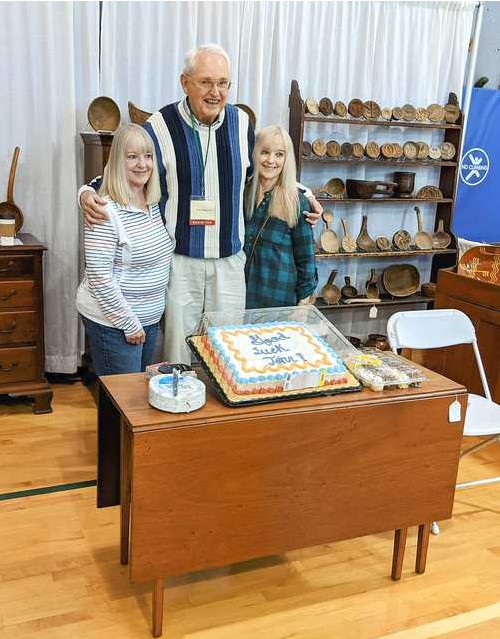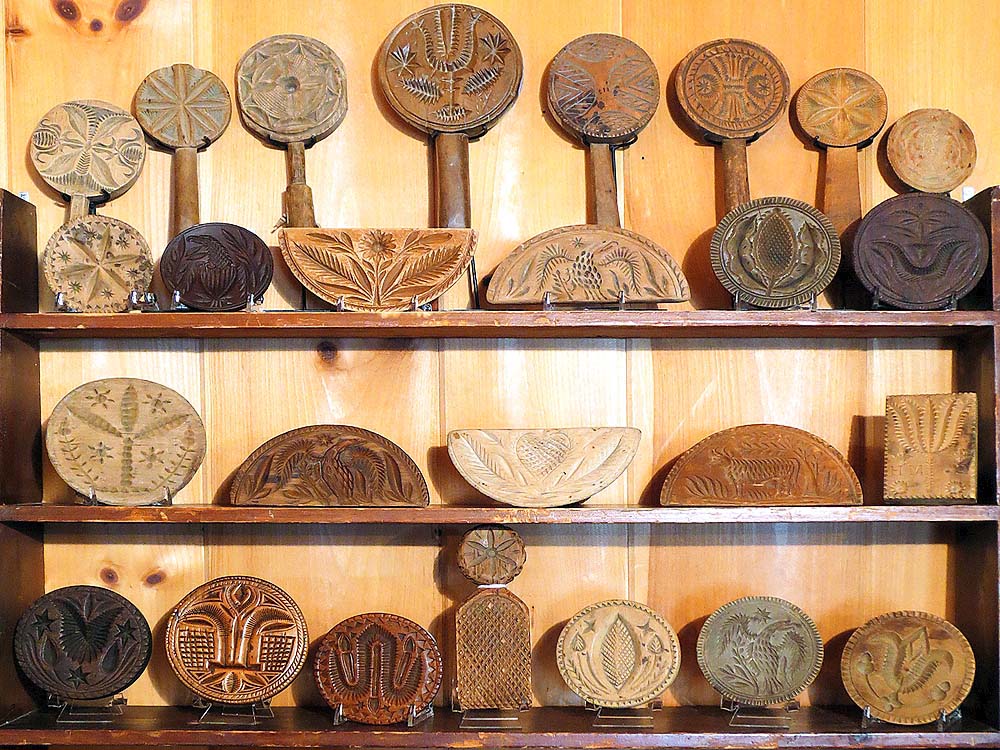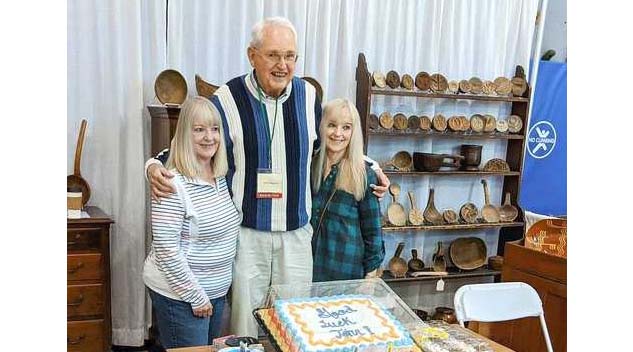#John #Rogers #Antiques #Arts #Weekly

John with the Wilhide twins, Edith Wilhide and Allie Beyer (Edith to the right], and Allie and her husband, Wayne, are co-promoters along with Gene and Chris Bertolet for the Elverson Antiques Show.
Word reached Antiques and The Arts Weekly that an old friend and well-respected longtime dealer John Rogers was “semi-retiring” following a show he recently did in Elverson, Penn. It might have been the antiques specialist and butter mold and butter print expert’s last exhibition at a brick-and-mortar venue, but he fully intends to spend more time collecting. We dialed him up to see if there were more details on his next chapter to pass along to our readers.
We will surely miss seeing your handsome displays of butter prints, bowls, burl, other woodenware and colorful ceramics at shows. What is behind your decision to step away from actively participating in them?
Health issues, and the fact that I am approaching in two months’ time my 87th year. I am not immune from all of the issues that people of that age have. It’s just too hard now. I don’t have the strength, I don’t have the energy. The problem is that I’m just too darn old. I haven’t found anyone in all of my visits with physicians that could make me 30 years younger.
You had a little celebration at the Elverson Antiques Show with cake and well-wishers. Camaraderie is such a big part of being on the road, setting up, packing out and presenting your merchandise. What will you miss most about it?
What I will miss the most are the people — other dealers who are just wonderful and also customers who have turned into friends. The people that I have known in the antiques business are some of the finest people I’ve ever met. That’s the short but accurate answer to your question.
How long have you been collecting, buying and selling — and what got you started?
I was a collector before I was a dealer, and my wife and I always enjoyed living with antiques. When I was employed we would go to antiques shows and auctions whenever we could, but we were buying for ourselves. The collections that we started then became the basis for my stock as a dealer. Many of the things that I have sold are things that we bought years back for our own house. We’re no longer going to have room for all that we have enjoyed so it’s time to pass it along.
When Sue and I got married, we lived a couple of hours away from her aunt and uncle with whom she had been very close. They enjoyed antiques and had a hobby of buying and selling antiques from their house. We learned from them. Sue was more knowledgeable than I about the stuff, and both of us loved it. But I had to earn a living. I never felt that I could earn a living and support a couple of kids in the antiques business.
Does Sue have the same collecting sensibility that you have?
I use her good judgment, particularly when I am buying. I think she has a very good eye, not only for the item and how well represented she thinks it is, but also from the perspective of how much I should pay for it. I rely on her for that. She does not do antiques shows with me because she has physical problems and it’s very hard for her to be on her feet at a show.
Do you have children to which you can pass some of these things along?
We have two wonderful children who have absolutely zero interest in any of these things [chuckles]. In a certain sense, it makes it easier for us. Because we don’t have to say, “Oh, well, Sarah has always wanted this but David has, too, and what do we do, how do we settle that between the two of them.” When neither one of them wants our stuff, it really makes life so much easier.
Can you give us a little history on butter prints? And what is the oldest or most rare example in your collection?
They’re purely decorative, nothing but folk art today. I don’t know anyone who uses them. They were useful when people made their own butter and took it to market, because the impression functioned as a trademark. In many cases, they remain examples of really excellent carving. Butter prints were not originated in America. Some of the finest prints in my collection are English. Right around 1850 a gentleman developed a butter print in combination with a mold. The mold enabled the person who was trying to sell butter to avoid the necessity of weighing it to figure out whether they had a pound, half pound or quarter pound. The mold was designed to be used for a specific weight.

You do actively sell through your website — www.johnrogersantiques.com. Will you continue with that, adding new inventory as items are sold?
That’s to be determined. It depends on a large number of factors, primarily relating to space. As it appears, we’re going to be living in a retirement facility. We’re not going to be spoiled by having a barn and all kinds of storage space.
What goes on in New London, N.H., during the winter season?
I think it depends on your age. We have friends who are much younger than we, and they say they simply cannot wait for winter because they love to ski, they love winter hikes, they love to snowboard and ice skate and all of the winter sports they adore. Now we are past that age. Winter in New Hampshire is simply indescribable. Something that has to be seen to be believed. We get in the car, look at what is surrounding us and say that is so worthwhile!
—W.A. Demers




